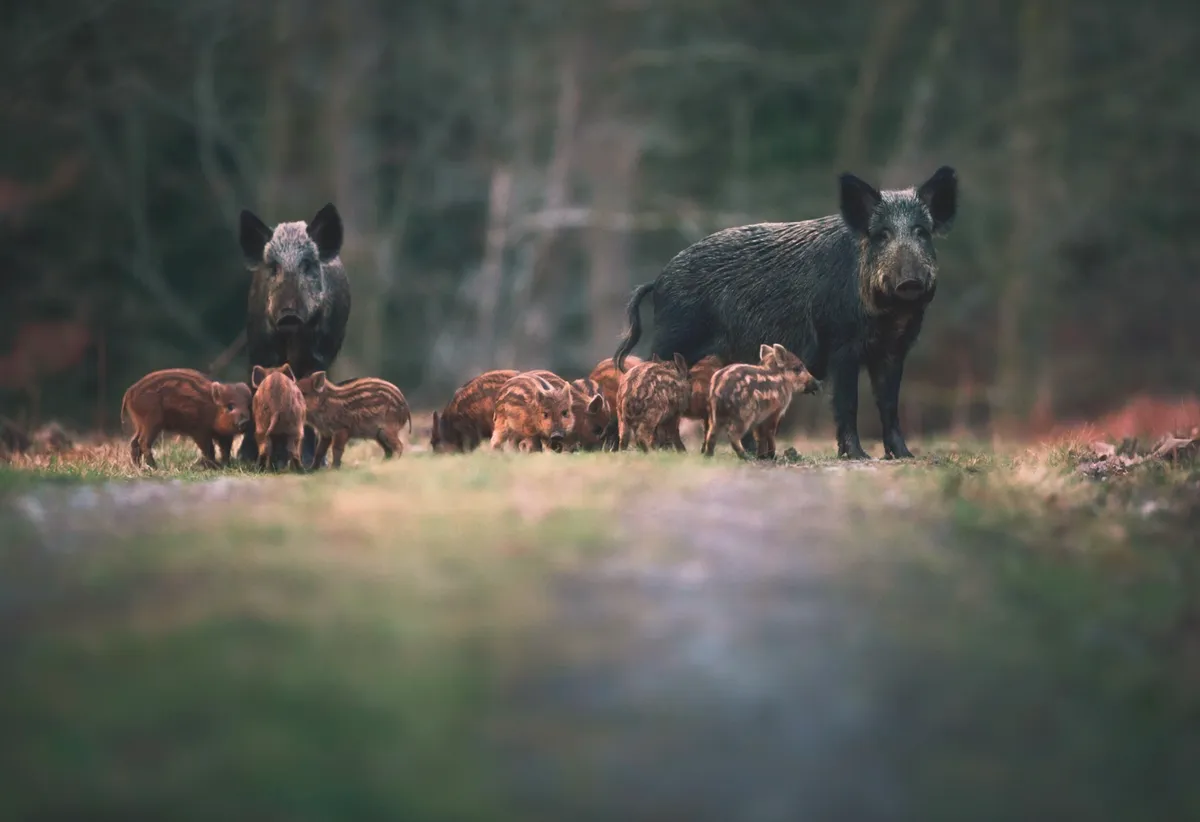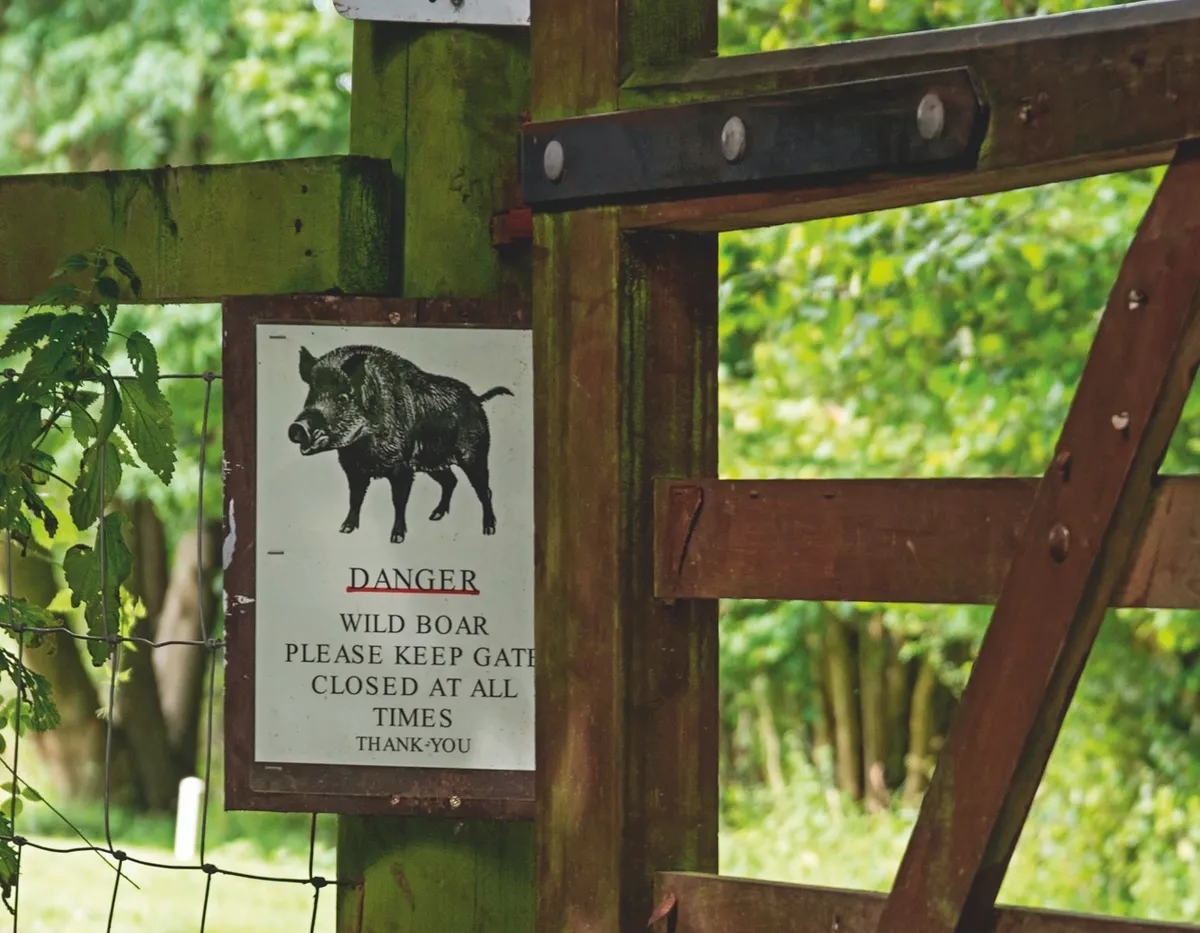I’ll never forget the first time I encountered wild boar in the Forest of Dean. It was early autumn. I was cycling with my two-year-old daughter, who’d just nodded off in her bike seat, when we stopped for a water break.
I heard a low rustling sound among the ferns and fallen leaves and, suddenly, there they were, a family of about seven, emerging from the forest and crossing the path behind me. I woke my daughter and we both sat and watched them noisily digging the earth for grubs. We were completely entranced, then they vanished again among the trees.
Plan a bike ride in the Forest of Dean in Gloucestershire with our cycling route.

Rise of the boar
Sightings of these stout, bristly haired creatures are becoming more frequent in this ancient forest they’ve made home, growing in numbers since a group escaped from a farm in the 1990s, followed by an illegal release in 2004. No one knows for sure how many there are – it’s believed to be over 1,500 – but signs of them are everywhere, from wallow pits in the mud and tusk-scarred trees to churned-up grass verges. They are nature’s rotavators.
And there’s no better chance of seeing them than with a walk or cycle along one of the Forest of Dean’s numerous trails. One I do frequently is the Family Cycle Trail, a 10-mile circular route that follows waymarkers along the old Severn and Wye railway line, passing time-worn stations and former collieries through enchanting ancient woodland.

1
Steely deer
Start at the Pedalabikeaway cycle centre in the oak-wooded Cannop Valley. Cross the bridge over the road and follow the trail as it heads uphill – it’s not too strenuous, but will give your thighs an early workout. Keep your eyes peeled on your right for a deer sculpture among the trees, made entirely from steel rods and wire. After you pass under a horseshoe-shaped bridge, you’ll soon come to Drybrook Road Station.
2
Blazing trails
If you’re cycling with young children and the full 10 miles seems a bit of a stretch, you can turn right here for the Hicksters Way Loop – a five-mile route back to the cycle centre. Otherwise, continue straight ahead.
Cycling among the ruddy blaze of oaks, beeches, larches and sweet chestnuts, it’s easy to forget that this land has been shaped by industry, from tree-felling for shipbuilding in the 16th century to coal mining in the 19th and early 20th centuries. Relics of this past are dotted throughout the forest, including the former Lightmoor Colliery at Foxes Bridge, which closed in 1930. You’ll pass this old colliery, then another at New Fancy.

3
Step into the map
From the old spoil heap lookout, enjoy spectacular views across the treetops – you might even see a buzzard or goshawk soaring above. The vista also has a Geomap – a fascinating walk-on map that depicts the underlying geology, mines and quarries of the forest. From here, it’s a thrilling descent, filled with twists and bends. You’ll pass a mighty ancient oak tree, where men from the local collieries used to gather for their union meetings.
4
Forest protection
When you reach Speech House Road station, get off your bike to cross the street. The station’s namesake, Speech House, now a rather luxurious hotel, was originally built as a hunting lodge for King Charles II in 1669. Verderers Court, a room in the house where judgments took place over 300 years ago, is now a fine-dining restaurant. Judicial officers, known as Verderers, dealt with shady behaviour in the forest, including the poaching of deer and illegal cutting of woodland. Today, regular verderers meetings are still held at Speech House to discuss management of the vert (woodlands and open land), deer and, of course, the mischievous wild boar. Walkers and cyclists can enjoy a well-deserved afternoon tea in the hotel’s Orangery.

Cross the road bridge again and then head back to the cycle centre where you can rest your weary legs in a café buzzing with mud-splattered mountain bikers.
Alternative ways
The initial stretch of the Family Cycle Trail links with the forest’s famous Sculpture Trail – a 4.5-mile walking route installed in 1986. Each of its works of art are inspired by the wildlife, folklore and the industrial heritage of the forest. My favourite is Cathedral, a spectacular stained glass window suspended from the tree canopy, depicting the wonders of nature. A series of new sculptures were installed in 2016 to mark the trail’s 30th anniversary.

The walk begins and ends just off the B4226 in the centre of the forest at Beechenhurst Lodge – a bustling hub for exploring the area, where you’ll find a play area, a café, BBQs and a treetop adventure park.
Beechenhurst is also the starting point for the newly installed Gruffalo Trail – kids will love hunting for clues to discoverer the clawed beast himself on this interactive adventure in the woods. Who knows, the snuffling snout of a boar might also make an appearance during the day’s activities.
Friends or Foes?
While the presence of boar in the Forest of Dean is something of a bittersweet upheaval for the local authorities (after all, they do make a lot of mess), this 27,000-acre historic woodland is now their home. For visitors like me, seeing them grunt and scuttle among the trees is magical, while some local residents have even grown fond of their surprise appearances and digging frenzies on their lawns.
Boar safety guide

Wild boar can grow to be strong, large animals and may defend their young when threatened. Mock charges and attacks are rare, but they do sometimes occur, particularly around aggressive dogs.
If you see a boar:
• Keep your dog on a lead
• Do not feed the boar
• Do not approach the boar
• Walk away steadily
